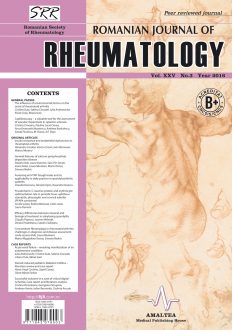SELECT ISSUE

Indexed

| |

|
|
|
| |
|
|
|

|
|
|
|
|
|
| |
|
|
HIGHLIGHTS
National Awards “Science and Research”
NEW! RJR has announced the annually National Award for "Science and Research" for the best scientific articles published throughout the year in the official journal.
Read the Recommendations for the Conduct, Reporting, Editing, and Publication of Scholarly work in Medical Journals.
The published medical research literature is a global public good. Medical journal editors have a social responsibility to promote global health by publishing, whenever possible, research that furthers health worldwide.
Efficacy differences between classical and biological treatment in ankylosing spondylitis
Claudiu Popescu, Jasmin Mehrabi, Denisa Predeteanu and Cătălin Codreanu
ABSTRACT
Objectives. The study aims at comparing classical and biological treatment of ankylosing spondylitis (AS) in terms of efficacy and to determine which treatment type is a significant predictor of low disease activity in a reallife clinical situation.
Methods. The study was cross-sectionally designed to include all the patients randomly admitted between January and July 2015 to the “Sfanta Maria” Clinical Hospital Department of Rheumatology and discharged with a diagnosis of AS according to their attending physicians. The retrospectively collected variables (demographics, disease phenotype and activity, treatment, laboratory measures) were analyzed using appropriate statistical tests (Mann Whitney, χ2, linear and logistic regression).
Results. The study sample included 105 cases of established AS with a mean age of 43.2 years: 64 patients (60.9%) were on tumor necrosis factor inhibitors (TNFi: adalimumab, etanercept or infliximab), 55 (52.4%) took non-steroidal anti-inflammatory drugs (NSAIDs) and 30 (28.6%) had sulfasalazine. TNFi were associated with lower disease activity compared to NSAIDs and sulfasalazine and they were significant predictors for low BASDAI (Bath Ankylosing Spondylitis Disease Activity Index), either as mono-therapy or combined with NSAIDs and/or sulfasalazine.
Conclusion. TNFi are more efficacious than NSAIDs and sulfasalazine for the treatment of AS. A combination of TNFi with NSAIDs (and sulfasalazine for peripheral arthritis) would be the ideal therapeutic association.
Keywords: ankylosing spondylitis, TNF inhibitors, NSAIDs, sulfasalazine
